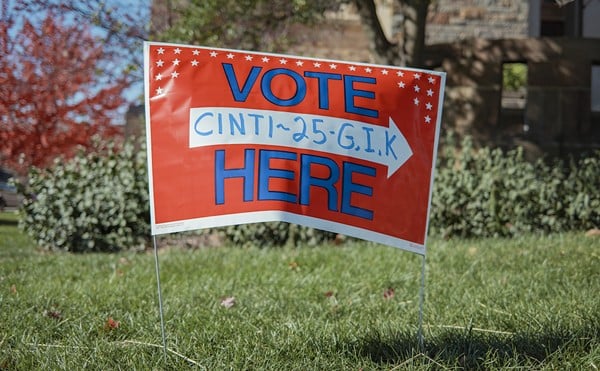Given the predominant impression of Cincinnati nationwide as a bastion of conservative thinking and influence, the area often goes unnoticed as a historical breeding ground of progressive dissent and activism. Historian Andrea Kornbluh is out to shed some light on this city's surprising, and often neglected, alternative underbelly.
A teacher of history at the University of Cincinnati's Raymond Walters College, Kornbluh has a particular affinity for uncovering unusual history, including that of the women's movement and race relations.
"One of the threads I sort of follow is people who try to change the world that they live in," Kornbluh says. "Women and African Americans have usually not been at the center of power and influence."
So she has plans for a Web site — called Alternative Cincinnati — to serve as "a virtual tour of Cincinnati to celebrate the millennium." The tour will include individuals who have had alternative, radical or utopian visions of the city's future. Kornbluh's aim is to gather into one place those individuals (and sites relating to them) who most challenged the existing society in Greater Cincinnati over the past 200 years.
"These tend to be people who were viewed as crackpots, troublemakers and people who just didn't fit in," Kornbluh explains. Such folks were typically ostracized, jailed or driven out of town.
Kornbluh's earliest entry so far is Frances (Fanny) Wright (1795-1852), the first woman in America to act publicly to oppose slavery. Wright delivered her historic speech on the Hamilton County Courthouse steps in 1828.
In the late 1820s, areas near Cincinnati were magnets for radical and utopian activism, including the town of Utopia, Ohio, about 20 miles up river, and the colony of New Harmony, Ind., established by Robert Owen around the same time.
In 1829, Wright wrote, "The city of Cincinnati had stood for some time conspicuous for the enterprise and liberal spirit of her citizens, when, last summer, by the sudden combination of the clergy of three orthodox sects, a revival, as such scenes of distraction are wont to be styled, was opened in houses, churches, and even on the Ohio River. A circumstantial account of the distress and disturbance on the public mind in the Ohio metropolis led me to visit the afflicted city; and, since all were dumb, to take up the cause of insulted reason and outraged humanity."
Wright is buried in Spring Grove Cemetery. Most of her colleagues — known as "The Cincinnati Sisters" — fled the city after a few years, ending up in Oberlin, Ohio, where they could continue their work of educating and integrating African Americans into society without the hostility they encountered in the Queen City.
More recently, Reuel Stanfield was an active socialist in the "Red Scares" of the 1950s. He died in 1961 after 30 years as a labor organizer, coming to Cincinnati after being framed by California police for a dynamite job (what today would be called "terrorism") he didn't do and for which he was later pardoned.
Stanfield found Cincinnati even more oppressive than the West Coast. Cincinnati police also arrested him and charged him with unsolved dynamitings, but later dropped the charges. This happened shortly after he was dragged before the Ohio Un-American Activities Committee in 1952. He once commented that "the lackeys of capitalism were forbidding (him) to think," but he steadfastly refused to leave. "Let me leave," he declared, "and the bastards'll be picking on someone who can't take it as good as me."
Working for gradual change within the Democratic Party, where he saw some faint glimmer of hope, Stanfield delivered record numbers of votes from his poor, all-white precinct to the lone black candidate on the Democratic city council slate. In 1957 he was called in for questioning before the Senate Internal Security Subcommittee. He refused to say whether he was or had been a Communist or to clarify whether he was an undercover agent placed in Cincinnati by the Kremlin. Stanfield made his home on Mercer Street in Over-the-Rhine and is buried in Newtown Cemetery.
"These people usually don't have large followings and aren't really popular," Kornbluh says of the candidates for her tour. "The question of getting access to the media in the 20th century makes it difficult for them to get their stories told. They don't fit neatly into official history."
Yet some of Kornbluh's characters might cross over into official history as well, depending on how attitudes regarding certain individuals change over the years, especially after their death. Figures such as the Rev. Maurice McCrackin or Buddy Gray are sanctified by death while ignored or regarded as public nuisances during their lives.
"But what happens," explains Kornbluh, "is that their more radical edges will be rounded off to make them more palatable. (But) it'll be a while before Cincinnati sanctifies Buddy Gray."
Kornbluh says she would like people to contribute names of those who really had an alternative vision for the city. "I'd like more information than just the person's name," she says. "Also clues for how to document their vision: photos, newspaper clippings, places associated with them, letters, things that help tell their story."
Kornbluh has no deadline to launch her Web site, other than during the millennial year (technically 2001), but she wants a wide representation and is working now to flesh out the project.
Criteria for inclusion are: (1) death before Jan, 1, 2000; (2) significant part of life spent in Greater Cincinnati; (3) demonstration of commitment to alternative vision of city's future; (4) sources and documents of their existence and contributions; and (5) a physical site or location connected with them.
Send nominations to A.T. Kornbluh, Department of History, Raymond Walters College, University of Cincinnati, 9555 Plainfield Road, Cincinnati, OH 45236-0086. Or e-mail her at Andrea.Kornbluh@uc-edu.





